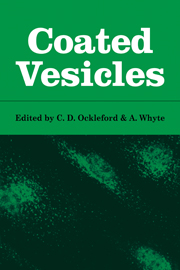Book contents
- Frontmatter
- Contents
- Preface
- Foreword
- List of contributors
- 1 Coated vesicles: a morphologically distinct subclass of endocytic vesicles
- 2 Coated vesicles in different cell types: some functional implications
- 3 Coated vesicles: their occurrence in different plant cell types
- 4 Immunoglobulin transmission in mammalian young and the involvement of coated vesicles
- 5 Coated vesicles in neurons
- 6 Coated vesicles in the oocyte
- 7 Adsorptive and passive pinocytic uptake
- 8 Coated vesicles and receptor biology
- 9 Coated secretory vesicles
- 10 Dynamic aspects of coated vesicle function
- 11 Structural aspects of coated vesicles at the molecular level
- 12 Coated vesicles in medical science
- Appendix 1 Nomenclature
- Appendix 2 References added at proof
- Author index
- Subject index
- Plate section
6 - Coated vesicles in the oocyte
Published online by Cambridge University Press: 04 August 2010
- Frontmatter
- Contents
- Preface
- Foreword
- List of contributors
- 1 Coated vesicles: a morphologically distinct subclass of endocytic vesicles
- 2 Coated vesicles in different cell types: some functional implications
- 3 Coated vesicles: their occurrence in different plant cell types
- 4 Immunoglobulin transmission in mammalian young and the involvement of coated vesicles
- 5 Coated vesicles in neurons
- 6 Coated vesicles in the oocyte
- 7 Adsorptive and passive pinocytic uptake
- 8 Coated vesicles and receptor biology
- 9 Coated secretory vesicles
- 10 Dynamic aspects of coated vesicle function
- 11 Structural aspects of coated vesicles at the molecular level
- 12 Coated vesicles in medical science
- Appendix 1 Nomenclature
- Appendix 2 References added at proof
- Author index
- Subject index
- Plate section
Summary
One of the most striking aspects of oogenesis is the remarkable growth that is undertaken by the oocyte. This is normally taken to be an adaptation for providing the embryo with the substances needed to sustain full development. In fact, with the exception of mammals, oocytes of most species achieve this by accumulating large quantities of reserve material generally referred to as yolk. The latter may either be derived from the maternal blood stream, in which case it is called heterosynthetic, or, alternatively, synthesised by the oocyte itself, and is then termed as autosynthetic (Schechtman, 1955).
Although coated vesicles may form in oocytes of numerous species, irrespective of their reproductive biology, it is quite apparent that micropinocytosis in oocytes plays a major role only when yolk is formed by heterosynthetic processes. In fact, as in other cell types, micropinocytosis in these instances provides a method of engulfing large molecules and sequestering them within an intracellular compartment which remains separated from the rest of the cytoplasm by a limiting membrane. However, substances ingested into the oocyte normally do not undergo intracellular digestion soon after uptake but are stored for a definite period of time prior to their final utilisation.
For the reasons outlined above, it is clear that certain species are better suited than others for studying the processes of micropinocytosis in oocytes (by biochemical as well as ultrastructural methods).
- Type
- Chapter
- Information
- Coated Vesicles , pp. 135 - 178Publisher: Cambridge University PressPrint publication year: 1980
- 11
- Cited by



